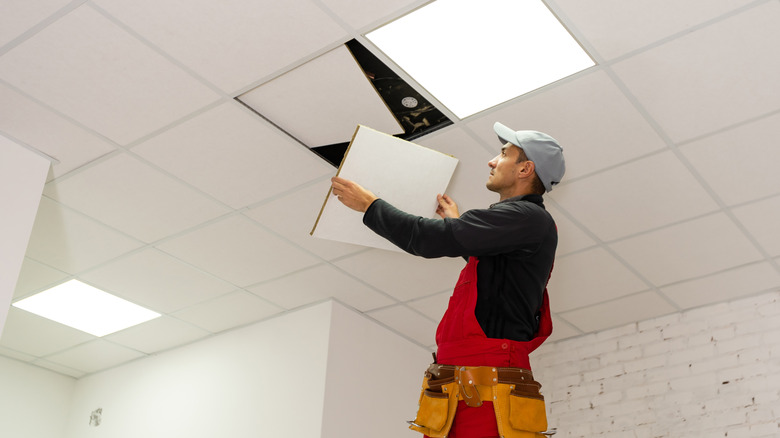Do Popcorn Ceilings And Crown Molding Go Together? Here's What Our Expert Says
If you purchase a home, some of the design choices that you inherit may seem strange. For example, why do homes have popcorn ceilings? The odd texture creates some problems for homeowners, like collecting dust and giving the room a dated look. However, popcorn ceilings have some advantages, too, such as covering imperfections in the drywall. Before deciding whether you want to remove the popcorn ceiling, you may wonder whether it harms your ability to make other design changes, such as adding crown molding to the room for a feeling of elegance while making the ceiling look less dated.
To determine whether popcorn ceilings and crown molding can co-exist in your favorite room, we decided to reach out to our House Digest expert, Sarah Bilotta, who is a design historian. From an aesthetic standpoint, she said the two design elements are so different stylistically that pairing them isn't the right choice for most people. "Popcorn ceilings were once a cheap solution to a lot of problems ... Crown molding, on the other hand, is an elegant and classical adornment evocative of the upper-class homes of Georgian England," she tells House Digest in an exclusive interview. "It has remained consistently popular and comes in all sorts of designs, from plain to opulent."
Bilotta's verdict? "I don't think crown molding and popcorn ceilings go together," she says. "Because popcorn ceilings are usually quite cheap and crown molding is typically associated with more lavish and ornate homes, putting them together feels like putting gold gilt on a plastic lawn chair."
If you still want to add crown molding to your popcorn ceiling, watch out for these issues
You might have your heart set on adding crown molding without removing the popcorn ceiling, meaning you're going to ignore the fact that the two offer different vibes from a design standpoint. If so, Bilotta says that you need to be ready for the challenges of properly installing crown molding in a room. For example, the bumpy texture of the popcorn ceiling can affect the ability to create straight lines with putting the crown molding tight to the ceiling. Additionally, "if you are DIY-ing a crown molding, know that lining up edges takes a lot of precision and measuring," Bilotta tells House Digest in an exclusive interview. "Plus, ceiling-oriented home improvements are always hard on the back, shoulders, and arms. Consider having a friend or family member help you."
Bilotta says that the DIY work you're putting into hanging crown molding might be better served by scraping the texture off the popcorn ceiling. "DIY-ing your crown molding and DIY-ing popcorn ceiling removal cost about the same — varying slightly depending on the tools and supplies you use," she says. "While doing a DIY popcorn ceiling removal is a much greater investment of time, I think it's worth your time and money more than adding moldings to distract people from your popcorn ceiling. ... In my opinion, it's always worth it to put in the extra money to do a job right, rather than spending money on a cover-up."
Other ways to hide a popcorn ceiling before you choose whether to add crown molding
Bilotta suggests finding a way to disguise your popcorn ceiling before going through the work of adding crown molding. You might find that you like the results of your work on the popcorn ceiling, meaning you don't really need crown molding to distract people from the dated look of the popcorn ceiling texture.
"My favorite way to cover up a popcorn ceiling is to paint it a dark color," Bilotta tells House Digest in an exclusive interview. "Dark colors do not reflect as much light, so they render the texture less visible. Plus, a rich, bold color like deep navy blue or rich emerald green can look equally luxurious whether the ceiling is textured or not." She adds that this solution is both budget-friendly and easier to do yourself. "If you eventually decide to remove your popcorn ceilings, you're not deeply invested in your previous restoration, and you can just scrape it off," she says.
Although Bilotta says she is not a fan of some popular suggestions for covering a popcorn ceiling — such as adding a drop ceiling — she does understand why people might choose options like this. A drop ceiling "lowers your ceiling height and can be work-intensive and expensive, depending on the materials you use," she says. "On the other hand, it does completely disguise your ceiling, which, in my opinion, makes it a better solution for the long term than adding crown molding."


